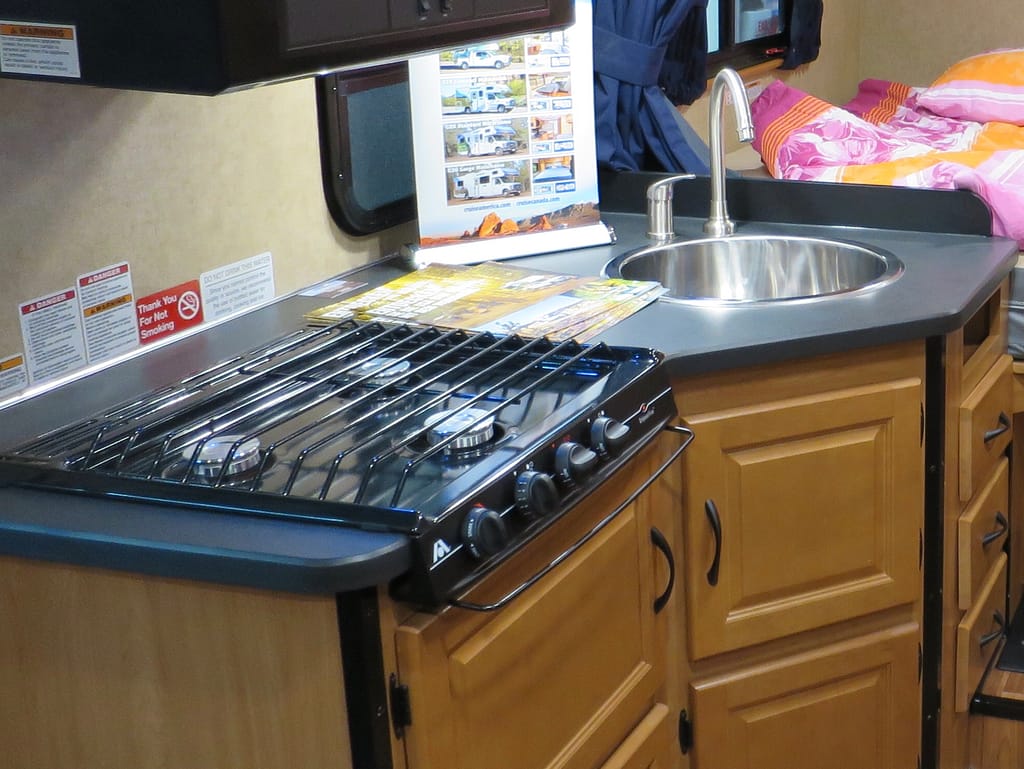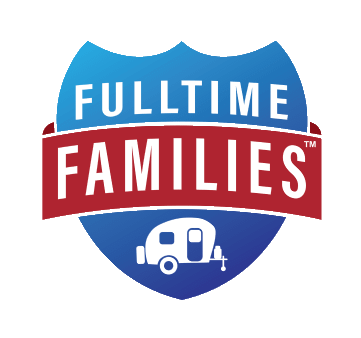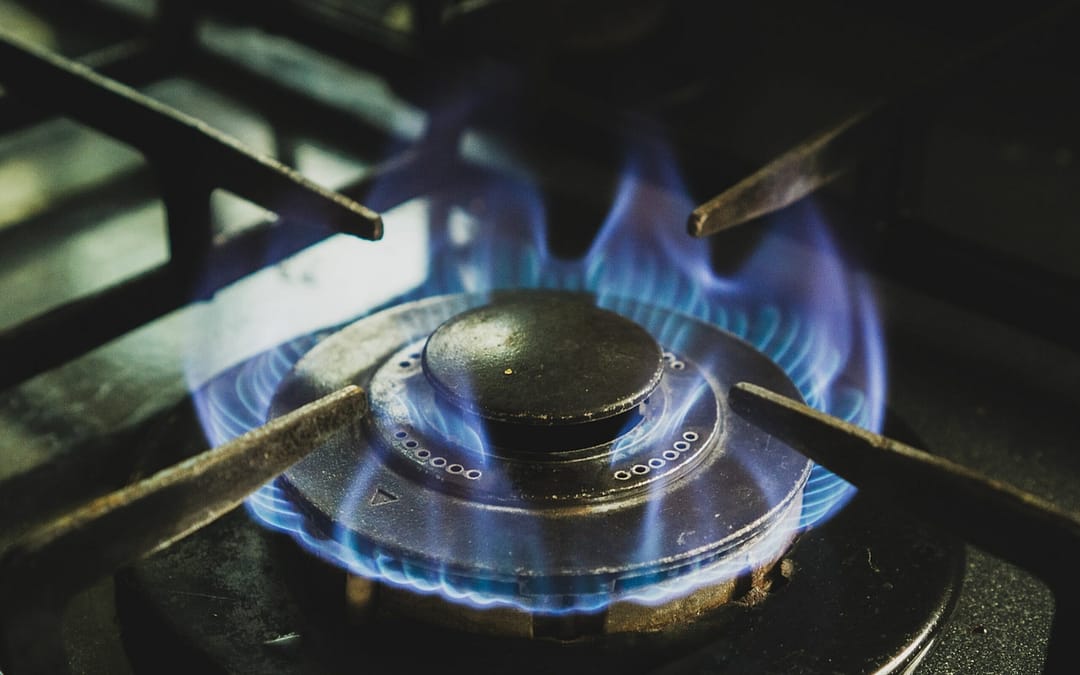This article may contain compensated links, please read our disclaimer for more information.
Pretty much every RV comes equipped with an RV stove. In some rigs, this might be a two-burner stove; in others, a three-burner model. Most RVs have propane stoves, but there are some that come with electric cooktops.
No matter what type of RV stove your rig has, you will want to know how to use it safely, what alternative options you might have, and what kinds of accessories you might need.
That’s where this article comes into play. Read on to learn everything you need to know about your RV stove!

Image source: Travelarz
Propane RV Stoves vs Electric Options
As mentioned above, the vast majority of RVs come with propane stovetops. Many RVers use these exclusively without issue. Others choose to use electric stoves instead. Still others use a combination of both electric and propane cooktops.
Read on to learn the pros and cons of each so you can choose the RV stove option that is best for you.
Propane RV Stove Pros
- The option to cook no matter where you are, whether or not electricity is available.
- Some people prefer cooking on gas stoves because they heat up quickly and respond to adjustments well.
- Because your propane stove is already built into your rig, you won’t have to spend time or money replacing it.
Propane RV Stove Cons
- Using your gas stove will mean using your propane to cook. When campsite fees include electricity, it can be more cost-effective to use an electric RV cooktop.
- Gas stoves put out a lot of heat. There are many electric cooking options out there that won’t heat up your RV as much as the propane stove will.
- Propane appliances have a tendency to put moisture into the air, something that can cause problems with condensation when winter rolls around.
Electric RV Stove Pros
- Because electricity is almost always included in camping fees, using an electric stove when in a site with hookups can be a cheaper option.
- There are a number of portable electric stoves out there, meaning you can choose the electric RV stove that is best for you.
- When you go electric, you won’t be adding moisture to the air (aside from any steam coming off of your food). You will also heat your home up less, something that you’ll be grateful for in the summer months.
Electric RV Stove Cons
- Sometimes campgrounds do charge for electricity, especially if you’ll be staying long-term. In these cases, you will have to pay to run your electric stove.
- Very few RVs come equipped with an electric stovetop. This means you will have to purchase your electric burners separately.
- Unless you have a generator or a very robust battery bank, you won’t be able to use your electric stove when no electric hookups are available. This can be a problem if you enjoy boondocking.
Our advice? Go ahead and use that gas stove when it makes sense to, but have a small electric burner on hand for those times when using the electric option is a better bet.
Operating a Gas RV Stove
If you do plan on using your gas RV stove, you will want to know how to use it. For the most part, the stove in your RV works much like a household gas stove would. That said, getting your RV stove started is a bit different and might seem confusing at first.
- To start, you will need to locate the knob for the burner you wish to use in order to get propane flowing.
- Push that knob in and turn it to the “light” position (some knobs don’t need to be in any particular position to be lit).
- If your stove has a spark knob, turn that until it clicks and lights the burner (sometimes this might take a few clicks). If your stove does not have a spark knob, use a lighter to light the burner.
- Turn the burner knob to the correct position for cooking and proceed to use the stove as you normally would.
This video might help you get a better understanding of how to use an RV stove:
RV Propane Stove Safety
Obviously, you will want to be safe with your gas RV stove. Fortunately, there isn’t all that much to know beyond the usual turning of pot handles to the inside of the cooking surface (to keep them from being bumped during cooking) and keeping young kids away from the stove. That said, we do have a few RV gas stove safety tips.
Always Use Vent Fans
You almost certainly have a vent fan in your kitchen, maybe even directly above the stove. This should always be turned on when the stove is in use.
Why? Well for one thing, the vent fan will help rid your home of the aforementioned moisture and the heat created by your RV stove. However, the more important reason is because the vent pulls excess carbon monoxide (CO) out of the RV. Generally, this CO is not a problem, but if you’ll be cooking for a long time or if there is an unknown problem with your stove, the vent fan can be a literal lifesaver.
Install a CO/LP Detector
You never know when one of your stove knobs might be accidentally bumped into the ‘on’ position, causing propane to leak into your home-on-wheels. Obviously, this is extremely dangerous and something you will want to be alerted of as soon as possible. Enter the CO/LP detector.
All RVs come standard with a CO/LP alarm. That said, if yours is missing or no longer working, you will want to replace it right away. This will keep you safe from unknown propane leaks.
Invest in Knob Covers
One way to prevent your stove knobs from being accidentally turned is to invest in knob covers like these. With these in place, little hands won’t be able to play with the knobs, and the occasional accidental bump while you’re moving through the kitchen won’t be a problem.
Do You Need an RV Stove Cover?
Knob covers and a CO/LP alarm are RV stove must-haves, but what about an RV stove cover? Is that something you should invest in? The answer is yes, if your RV didn’t come equipped with a stove cover, we have to recommend that you look into buying one.
Benefits of an RV Stove Cover
There are a few different types of RV stove covers, and the one you buy will determine the kind of benefits it offers. Some of the biggest pros of such covers include…
- Added counter space for food prep.
- A built-in cutting board (if your cover is made to be used as such).
- A built-in backsplash (if you have a fold-up model).
- A work surface that can be used elsewhere (over the sink, on the couch, etc).
Buying an RV Stove Cover
There are several RV stove covers on the market. The options below are all great picks:
- Camco Oak Accents Universal Silent Top Stove Cover
- Camco RV Stove Top Cover
- Camco 43704-A Decor Mate Stove Topper and Cutting Board
Diy Stove Cover
There’s also the option of making your own stove cover. Check out the video to learn how.
Electric Cooktop Option
Want to have an electric stove option? You could of course replace your RV stove entirely with an electric stove, but this is expensive and a lot of work. Instead, we recommend investing in a portable burner such as the Duxtop Induction Cooktop Model 9600LS in order to give yourself that electric cooking surface without all the work and excessive expense.
Hopefully by now, you have a good understanding of your RV stove and feel comfortable using it. With this knowledge you can hit the road with confidence, knowing you have the ability to eat an awesome meal no matter where you may land.
Join Fulltime Families
Fulltime Families Members get access to the best resources, community and discounts.
Fulltime Families is a participant in the Amazon Services LLC Associates Program, an affiliate advertising program designed to provide a means for sites to earn advertising fees by advertising and linking to amazon.com, amazon.co.uk, amazon.ca. Amazon and the Amazon logo are trademarks of Amazon.com, Inc. or its affiliates.

